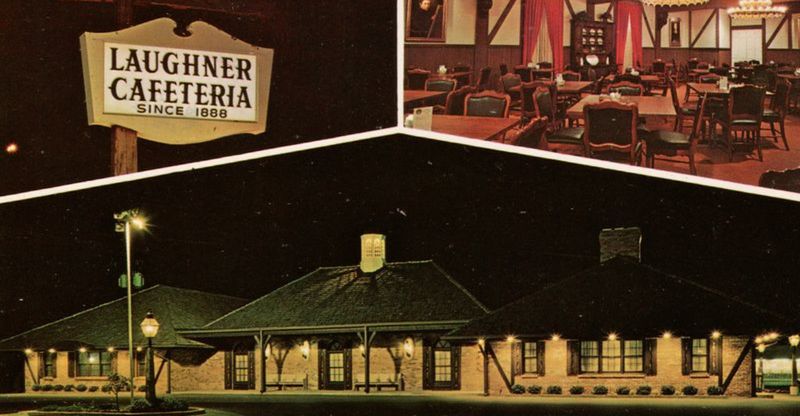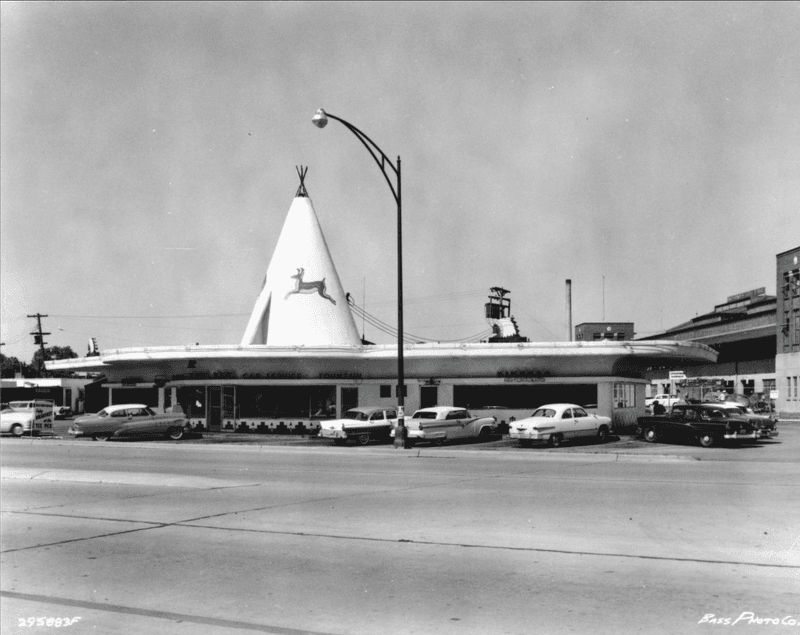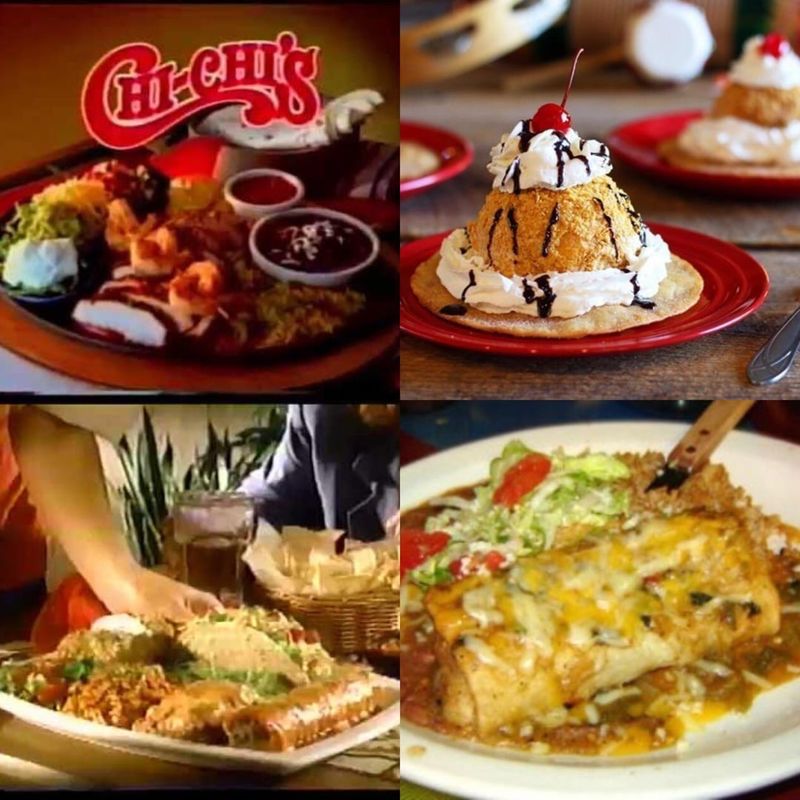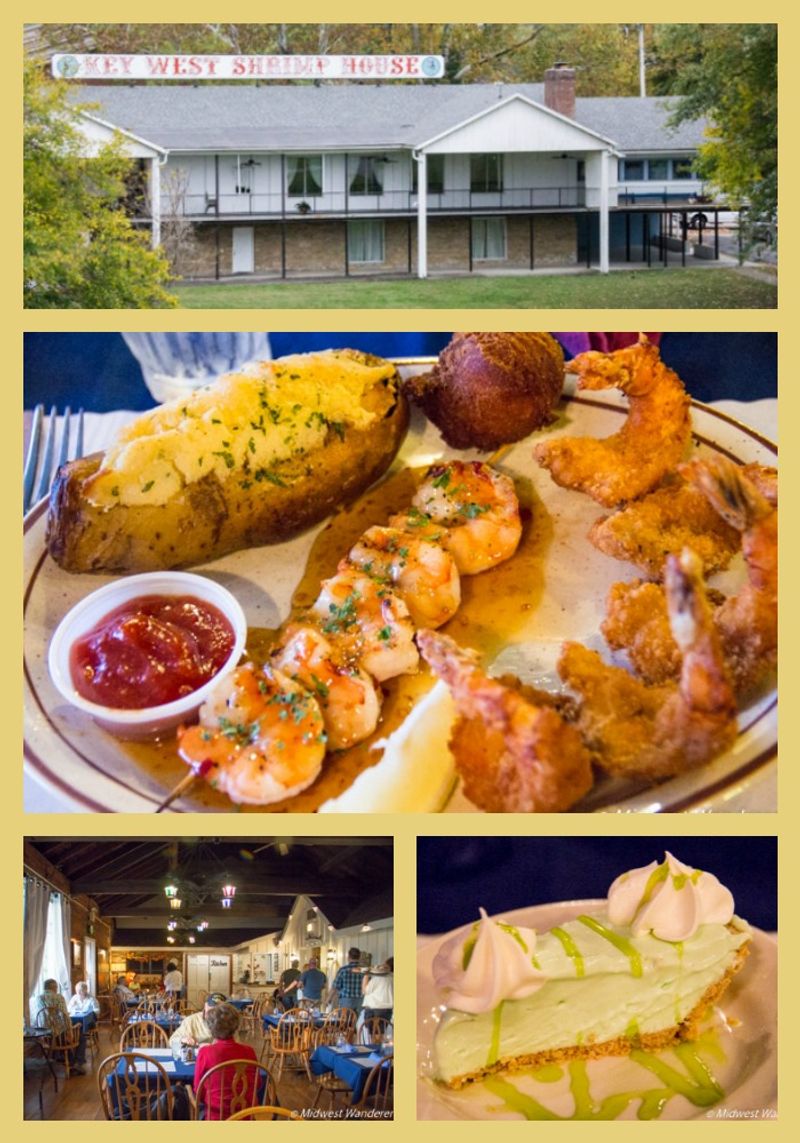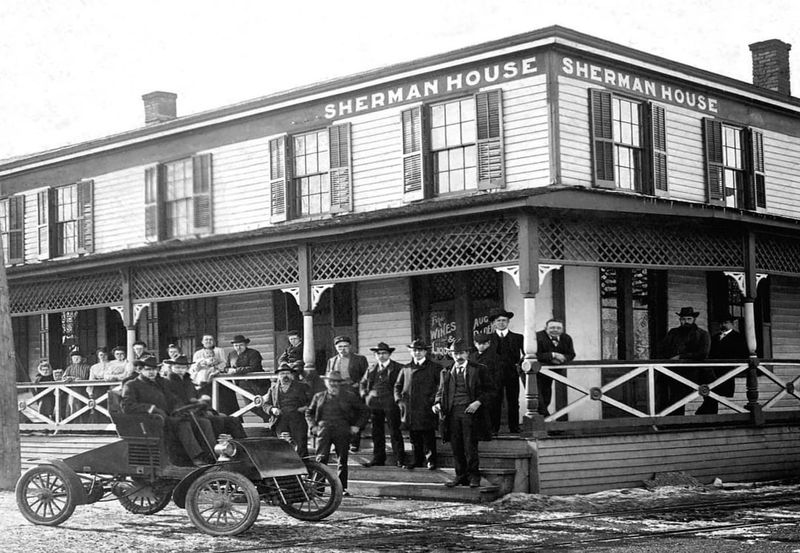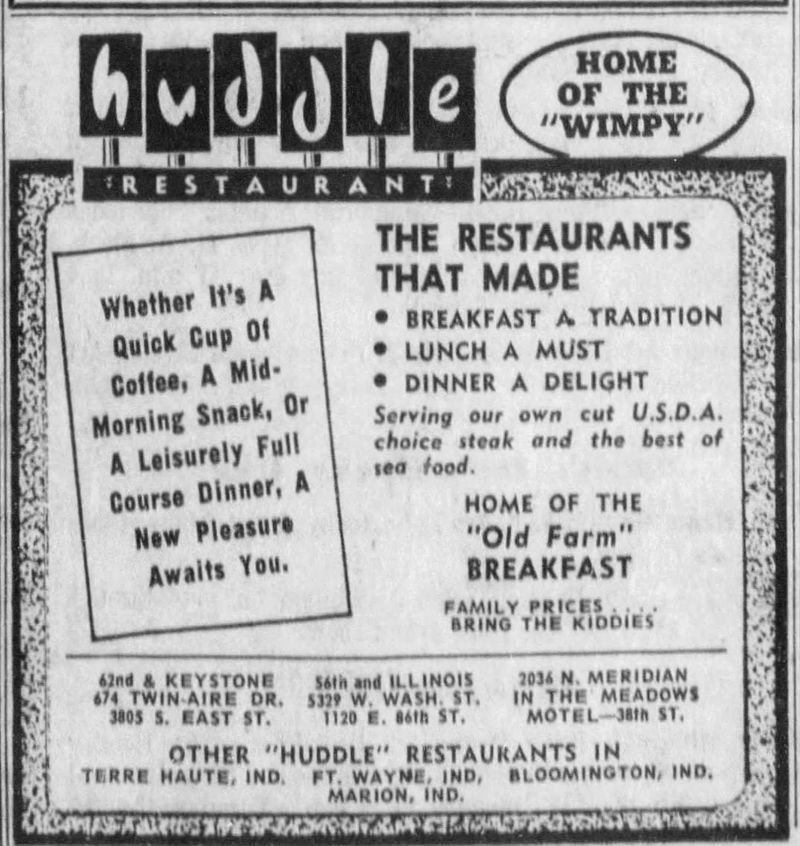Remember when a meal out felt like an event, not just a transaction? Indiana’s restaurant scene once sparkled with drive-ins, department-store tea rooms, and family-owned cafeterias that shaped our tastes and our traditions. These vanished spots served more than great food—they dished out memories, milestones, and a sense of place. Let’s revisit 15 beloved Indiana institutions we still miss and the flavors we wish we could order one more time.
Laughner’s Cafeteria, Indianapolis
From 1888 to 2000, Laughner’s Cafeteria defined everyday comfort for Hoosier families—tray in hand, eyes wide, choosing slices of meatloaf, golden fried chicken, and tall wedges of pie. The ritual felt reassuring: a friendly server, a clatter of plates, and a seat by the window before church, after games, or on weeknights when nobody wanted to cook. The food wasn’t fancy, but it was faithful, the kind of meal that anchored conversation and made room for seconds. When the last locations closed, Indiana lost a gathering place as much as a menu. Many still taste that chocolate pie in memory, feel the hum of the lunch line, and wish for just one more Sunday spread beneath those warm cafeteria lights.
Tee Pee Restaurant, Indianapolis
Opened in 1932, the Tee Pee was the neon heart of Indy’s cruising culture—cars circling, windows down, the promise of burgers, fries, and blueberry pie in a tee-pee-shaped icon. It wasn’t just a place to eat but a stage for Friday nights, post-game plans, and summer dates, all under the glow of drive-in lights. The seafood platters and fresh pies were legendary, but the vibe was the true draw. You could taste freedom in a root beer float and hear it in the rumble of engines. Long after the last tray returned, the Tee Pee’s silhouette still rises over stories shared at reunions and kitchen tables.
Brown Derby – Various Indiana locations
The Brown Derby imported a slice of Hollywood to Indiana, with velvet booths, glossy celebrity photos, and steaks that arrived sizzling. It felt like dressing up mattered—birthdays, anniversaries, and high-stakes business dinners unfolded beneath soft light and polished service. The menu balanced glamour and comfort: wedge salads, prime cuts, and cocktails mixed with a flourish. For many, it was the first brush with old-school elegance, a passport to a bigger world without leaving the neighborhood. When the lights dimmed for good, the Derby took with it a certain cadence of dining—the pause between courses, the linen napkins, the wink of a seasoned server. Its memory lingers like a last good sip of cabernet, warm and just a little bittersweet.
Ch‑Chi’s (Mexican chain) – Indiana
Ch‑Chi’s was the soundtrack of ’80s and ’90s family nights: sizzling fajitas drawing a parade of heads, a basket of warm chips, and salsa that never seemed to run out. Birthdays meant big smiles, clapping servers, and a dessert you had to make room for. The Tex‑Mex comfort—enchiladas, chimichangas, and frosty margaritas—felt festive without being fancy, a little vacation tucked next to the mall. For many Hoosiers, it was the introduction to tableside sizzle and a spice that wasn’t scary. When the chain disappeared, a specific kind of celebratory casual dining went with it. Today, the memory of that fajita sizzle can still turn heads, even if the plates are only passing through nostalgia.
Don Pablo’s, Indianapolis area
Don Pablo’s felt like the weekend, even on a Tuesday—clattering plates, margaritas salted just right, and platters generously heaped with Tex‑Mex favorites. Shoppers and birthday crews found the rhythm irresistible: queso arrives, laughter rises, and suddenly you’re staying for dessert. The décor leaned fiesta-forward, and the portions matched, a reliable formula for nights that needed little planning. After bankruptcy shuttered the Indiana locations around 2016, mall corridors seemed quieter and group dinners trickier to plan. It wasn’t haute cuisine; it was a mood, a dependable backdrop for celebrations big and small. The chain’s absence is a reminder that sometimes what we miss most isn’t the exact spice blend—it’s the sweet, noisy space where friends lingered longer than they meant to.
Gerst Haus – Indianapolis
At Gerst Haus, the clink of steins and the aroma of pretzels fresh from the oven made every night feel like a miniature Oktoberfest. Bratwurst platters, schnitzel, and potato pancakes arrived hearty and hot, accompanied by accordion tunes and plenty of Gemütlichkeit. It was the place to linger over a liter, swap stories, and share bites of apple strudel. While sister concepts may live elsewhere, the Indianapolis location carried its own neighborhood soul. Families marked milestones around long tables; coworkers became friends beneath the glint of beer steins. When it closed, the city lost a warm German hug of a restaurant—equal parts feast and fellowship. Today, memories rise like steam from a plate of sauerkraut, bright, savory, and hard to forget.
Sam’s Subway Restaurant Group, Indianapolis
Not the sandwich chain, Sam’s Subway was a quirky, unforgettable mix: cave‑themed décor, kosher deli sandwiches stacked high, and a black‑bottom pie that lived rent‑free in diners’ minds. It felt daring and different, an underground adventure with rye bread and dill pickles. Locals loved its personality—the playful design, the serious sandwiches, the memorable desserts. Bankruptcy ended the journey in 1978, but the legend lingers among those who crave character with their corned beef. In a world of copy‑paste dining rooms, Sam’s made weird wonderful. If restaurants are stories, this one read like pulp fiction: bold, textured, and a little smoky. People still swap tales about the décor and swear that pie could make a skeptic believe.
Key West Shrimp House – Indianapolis & beyond
Key West Shrimp House offered a seaside detour without leaving Indiana—porthole windows, nautical ropes, and plates loaded with shrimp, steak, and lemon wedges. The hush of carpeted dining rooms gave way to the crackle of fried seafood and the clink of cocktail glasses. Families posed by the ship’s wheel, date nights stretched into coffee and key lime pie, and a vacation mood drifted through the dining room. When it vanished, it took with it a sense of escapism that made weeknights feel special. The restaurant taught Hoosiers that ambiance matters, that a well‑placed porthole can reset your day. Today, we chase that shoreline feeling in landlocked ways, remembering the taste of butter, salt, and the sea we imagined.
The Tea Room at L.S. Ayres, Indianapolis
Above the bustle of the department store, the Ayres Tea Room served velvet chicken soup, airy pot pies, and dainty desserts with perfect poise. White gloves, polished silver, and “hobo lunches” for children turned shopping trips into miniature ceremonies. It was elegance made accessible, a reason to slow down and savor an afternoon. Generations learned table manners here, along with the joy of a well‑timed treat after finding the right dress. When the store and tea room faded, Indianapolis lost a social ritual stitched into its fabric. The memory endures in recipes passed down and whispered comparisons at modern cafés: nice, but not quite Ayres. Some places feed you; this one taught you how to savor.
The Sherman House, Indianapolis
The Sherman House embodied fine dining’s classic playbook: crystal chandeliers, white tablecloths, and service so smooth it felt like choreography. Business deals sealed over steaks, wedding toasts lifted with chilled champagne, and holiday dinners lingered past dessert. The menu prized precision—sauces glossy, vegetables crisp‑tender, and a dessert cart that could silence a room. It was where you learned the difference between dinner and dining. When it closed, an era slipped quietly away, replaced by quicker meals and louder rooms. People still remember the hush between courses, the way a waiter folded a napkin just so, and the soft light that made everyone glow. It was more than a restaurant; it was a finishing school in hospitality.
Tee Pee Restaurant (3rd Location), Indianapolis (Nora)
Nora’s Tee Pee outpost opened on East 86th Street in 1964, bringing the beloved drive‑in formula north: fast burgers, shakes, and a scene built for cruising. Though it closed by 1968, its short life looms large for those who came of age in that corridor. The location proved how powerful an icon the Tee Pee had become—recognizable architecture, familiar flavors, and a built‑in social network of car lovers and late‑night snackers. Even brief chapters can shape a city’s memory. Ask longtime Nora residents about their first dates, their first cars, and they’ll steer you past that corner. The third location was a snapshot—quick, bright, and gone—but the image still develops in conversation today.
Burger Chef – Statewide Indiana
Born in Indianapolis in 1957, Burger Chef helped invent fast food as we know it—modular kitchens, flame‑broiled burgers, and the kid‑friendly Funmeal before its better‑known rival’s Happy Meal. Locations dotted Indiana highways, a beacon for families on the go seeking shakes, fries, and a toy that made the backseat quiet. The brand’s characters and commercials still echo in memory, cheerful and a little space‑age. When the chain vanished, it left behind a blueprint many others followed. For Hoosiers, it’s a first taste of independence—a dollar allowance, a counter order, a burger wrapped with possibility. Nostalgia lingers strongest where innovation met everyday life, and Burger Chef sat right at that intersection.
ShowBiz Pizza – Indiana locations
Before screens followed us everywhere, ShowBiz Pizza made magic with animatronic bands, birthday crowns, and arcade tokens clutched in frosting‑sticky hands. The pizza was a passport to the game room, the game room a portal to endless tickets and plastic treasures. Parents found a reprieve, kids found a kingdom, and the house band played on in winking, slightly eerie harmony. Indiana locations turned weekend afternoons into memories that still glitter. When the lights dimmed and the curtains closed, a particular brand of family fun faded too. Today, the soundtrack of whirring skee‑ball and mechanical applause survives in stories—and in the box of old tokens some of us still keep.
Roselyn Bakery – Indiana (state‑wide chain)
Roselyn Bakery perfumed Indiana mornings with the scent of Sweetheart Coffee Cakes, iced cookies, and the ever‑popular Zebra Brownies. Counters gleamed with trays of donuts and pastries that defined school fundraisers, office breaks, and weekend treats. Even after storefronts closed, the brand echoed on grocery shelves, a sweet reminder of storefront windows once fogged with sugar and steam. For many, Roselyn wasn’t just dessert; it was tradition—grandparents bringing a white box tied with string, kids peeking under the lid. The chain’s departure left a hole that cupcakes alone can’t fill. Memory tastes like cinnamon and chocolate stripes, and it lingers long after breakfast is gone.
The Huddle Diner – Indiana
The Huddle Diner was a 24‑hour safety net: pancakes at midnight, burgers at noon, coffee always hot. Stainless counters, bottomless refills, and a jukebox soundtrack made it a refuge for students, night shift workers, and insomniacs. The menu sprawled in that diner way—omelets, melts, pies—and the staff learned your order by the third visit. By 1976, the chain disappeared, taking with it a reliable place to land when everywhere else was dark. We miss the clatter, the chrome, and the soft neon that promised company at odd hours. Some restaurants feed hunger; The Huddle also fed time, turning late nights into stories.

